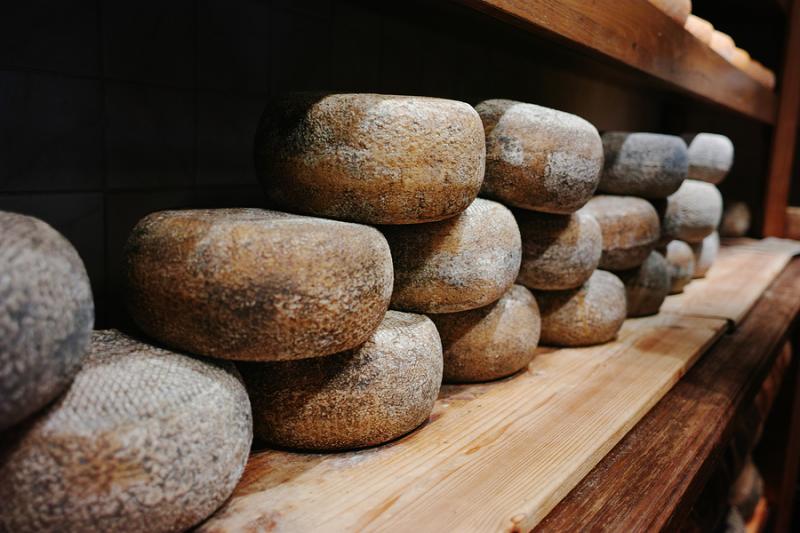It’s a fixed place on any Italian deli counter, a staple in fridges and larders across the peninsula. White and rubbery, beige and flaky, solid and golden, cheeseboards from Milan to Palermo are sure to contain a few varieties. ‘Parmesan’ may be better known internationally, for Italians, though, this humble, unpretentious cheese plays a far more important role in everyday life.
But what exactly is pecorino? And how can you recognise a good one?
Pecorino, as the name suggests, is made from ewe’s milk. This means the cheeses tend to have a sour note and depth that is uncommon in bovine products. This is not necessarily a negative trait. Historically, in fact, pecorino has been thought of just as highly as its cow-milk cousins. For ancient Italians, as the Byzantine historian Jordanes tells us, consuming dairy in adulthood was a trait of “barbarians and primitive peoples.” Ewe’s cheese, the sole exception to this rule, was seen as “civilised.”Bartolomeo Sacchi, the renaissance humanist, likewise condemns cow’s milk on the basis that it leads to “bloating and poor concentration”. Pecorino, by contrast, was seen to “help the stomach, eliminate occlusions of the liver, and lubricate the intestine.”
The first thing to get to grips with when choosing the right pecorino are the various ‘ages’. Pecorino fresco is mild, spongey, and usually used in salads. Some specimens can be rather bland, though a well-produced slab will exhibit a pleasant nuttiness. Semi-stagionato is more robust, ideal for an antipasto platter, or, depending on the variety, a filling for a panino. Such varieties are often served with honey or light jam and vary enormously in their depth and complexity. Finally, there are the fully stagionato cheeses, some of which are aged for as long as 36 months. Most people find these too strong to eat on their own so they’re usually reserved for grating onto pasta or amalgamating into sauces.
 [A variety of pecorino cheese aged in different varieties.]
[A variety of pecorino cheese aged in different varieties.]
While all the regions make pecorino in some shape or form, the most well-known types are generally found in central Italy. Tuscan cheeses in particular tend to be the most well-balanced. In Florence and Pisa, pecorino is generally served in thick chunks, eaten in large quantities, often without bread. Further south it is commonly wrapped in hay or chestnut leaves, or even mixed with truffles. One of the most celebrated varieties of all is the pecorino di pienza, which was much loved by Lorenzo de Medici and is usually recognisable by its black rind. While it’s hard to go wrong with any pecorino in the Val d’Orcia, this particular variant has a pleasing and distinctive note of laurel, thanks to the clayey soils that characterise the immediate area.
 [Traditional pecorino cheese from Pienza, Tuscany's cheese heaven.]
[Traditional pecorino cheese from Pienza, Tuscany's cheese heaven.]
Pecorino sardo– from Sardinia – is a different beast altogether. Walking through a typical summer market you’ll be able to smell the difference a mile off. These cheeses are earthy and animal-like, and often prove more divisive than Tuscan varieties. Sardinian cheese is, without doubt, an acquired taste, if nothing else thanks to the surprisingly dominant flavour of lamb rennet which, musky as it is, puts off some diners. Pecorino sardo is best served with fresh fruit – peaches and pears in particular - or a glass of the local red wine cannonau. Another use is in deserts, as in the famous seadas (deep fried pecorino fresco mixed with lemon and honey). This dish, which might be seen as Italy’s answer to the feta-based pies of Turkey and Greece, is one of the best examples of the sweet and savoury harmony that is at the base of so much Mediterranean cuisine.
 [Seadas - the most heavenly dessert one can have in Sardinia, Italy Magazine approved.]
[Seadas - the most heavenly dessert one can have in Sardinia, Italy Magazine approved.]
Of all the varieties of pecorino, though, pecorino romano is perhaps the most intriguing and distinctly Italian. Eaten on its own it can be almost unbearably salty; sharp and almost ‘stinging’ on account of its high acidity. The moment it’s heated up though, the cheese transforms, ‘broadening out’ to make way for a wonderful, savoury umami. The most common use of pecorino romano is as the basis for the cacio e pepe sauce, the deceptively simple fondue-like gloop that is a mainstay of trattorie in the capital. It’s also the key to ‘completing’ dishes like the carbonara, amatriciana and other much-loved Roman fare. Don’t be put off by the unassuming ‘egg white’ colour, pecorino romano packs a real punch and can bring a wild energy to primi piatti like no other topping.
 [Amatriciana served with pecorino romano cheese.]
[Amatriciana served with pecorino romano cheese.]
Like this article? Don't miss "Pecorino Romano: The Story Behind One of Italy’s Oldest and Most Famous Formaggi"
Cheese culture in southern Italy tends to be based more around caciocavallo, provolone and mozzarella than pecorino. One of the exceptions is pecorino siciliano. As with all the island’s produce it has a quite particular taste. At first it might seem similar to the Tuscan pecorino, at least in so far as it works well on its own and is best eaten semi-stagionato. The Sicilian cheeses, though, have smoky undertones that are quite unlike those of the mainland. When heated, and grilled in particular, they can even give a caramel-like touch to dishes. Pecorino siciliano is sometimes used as a ‘hidden ingredient’ in involtini alla messinese (beef rolls) to provide a flash of flavour, or to disguise the taste of old meat. Its malty quality also makes a nice change from the usual combination of mozzarella and parmesan in an aubergine parmigiana. One of the best ways to eat this cheese, though, is wrapped, quite simply, in a vine leaf on a barbeque. Served right off the heat, bubbly and sharp, it reveals itself to be an ideal ‘toastie’ cheese to rival a fine cheddar or gruyère.
There’s a time and place for experimenting in the kitchen. When it comes to pecorino, though, a little knowledge goes a long way. Understanding the basic principles of this complex ingredient is essential to appreciating the qualities and potential uses of the different types. You can’t go putting an old pecorino sardo in a salad, or a ripe cheese in a cacio e pepe. It simply won’t work. Keeping the fundamentals in mind - of where the milk is from, how long it has been aged, and what that means for its taste and texture - will make all the difference between a gastronomic triumph and a culinary catastrophe.












